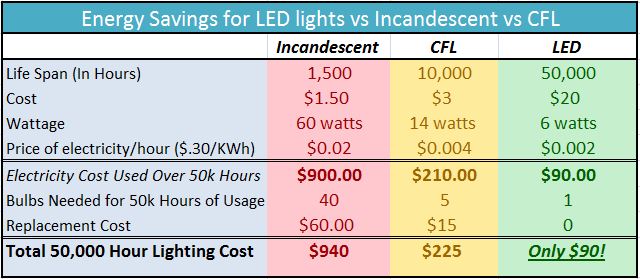You don't have to be perfect here, this is just an estimate. If you work 8 hour shifts, don't forget to add an hour at the end and a hour at the beginning of the day. We often find that there is usually someone there early and late, so you want to take all factors into consideration.
2. Estimating total fixture wattage:
Number of lamps x wattage of lamps x ballast factor = fixture wattage
Number of lamps should be relatively easy to count. To locate wattage of lamps, you can either go up and look at what you have or find the box of replacement bulbs on the shelf and you can find it there. Ballast factor, you would have to take a look at the existing fixture.
Analyzing Your Existing System:
3. Calculate existing energy use (kWh):
Existing fixture quantity x fixture wattage x hours per year = kWh
1000
4. Calculate existing total energy cost per year:
kWh x utility rate = yearly energy cost (in dollars)
 5. Establish maintenance cost:
5. Establish maintenance cost:
Total number of lamps x $6 (estimated industry average) = yearly maintenance cost
Having a good handle on the cost to maintain your system is very important if you are comparing a fluorescent system to a LED system. LED will always cost more upfront for the fixture vs fluorescent, but long term LED will cost you next to nothing for maintenance.
If you are not sure, use the $6 per bulb figure listed in the formula above. That is an established industry average. While you may think it costs nothing, if you really sit down and do a talley of bulbs, ballasts, down time, lift rental, safety, and labor, you will find the $6 figure a pretty close average.
Proposed System:
6. Calculate proposed energy use (kWh):
Proposed fixture quantity x LED fixture wattage (no ballast factor) x hours per year = kWh
1000
7. Calculate proposed total energy cost per year:
kWh x utility rate = yearly energy cost (in dollars)
Keep in mind that you are calculating costs of the existing system and proposed system in TODAY's dollars and utility rates. If you really watch your utility bill closely, you will find out that the rates creep up a little bit each year.
In 5 years if you start to think "why am I not saving the amount per month I estimated 5 years ago", you might want to break down your rates month by month (might need the computer for that). You will likely find a significant increase in your rate over time even though you did not notice the slight changes on the face of your bill.
At a dealership we did 3 years ago, their rate has increased nearly 40%, so I am talking from experience. Just something to keep in mind.
8. Establish installation cost:
Proposed fixture quantity x installation cost per fixture = total installation cost
9. Establish fixture cost:
Proposed fixture quantity x proposed fixture cost = total fixture cost
10. Total cost for proposed system:
Total installation cost + total fixture cost = total cost of proposed system
Determining simple payback (in years):
11. Calculate yearly energy savings:
(Existing kWh – Proposed kWh) x utility rate = yearly energy savings (in dollars)
12. Calculate yearly savings:
(Proposed total energy cost + proposed total maintenance cost) - (Existing total energy
cost + existing total maintenance cost) = annual savings (in dollars)
13. Simple payback formula:
Total cost of proposed system = simple payback (in years)
Annual Savings (in dollars)
What about NEW installations?
For new construction ROI calculations, you will need to subtract the cost of the existing system total from the total cost of the proposed system.
This number will be your new total for proposed system as shown below.
New Build formulas:
14. Establish additional proposed cost:
(Proposed fixture cost + Proposed installation cost) - (existing fixture cost + existing
installation cost) = adjusted proposed system cost
15. New build simple payback formula:
Adjusted proposed system cost = new build simple payback (in years)
Annual Savings (in dollars)
Learn More...
Related Articles:
How Much Savings From Retrofitting T-12 vs T-8 Lighting?
How To Calculate Watts For Analyzing Energy Efficiency Projects
How to Calculate the ROI For Energy Efficient Solutions

